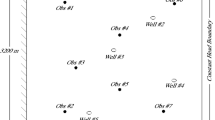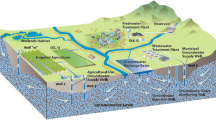Abstract
The interactive multi-objective genetic algorithm (IMOGA) combines traditional optimization with an interactive framework that considers the subjective knowledge of hydro-geological experts in addition to quantitative calibration measures such as calibration errors and regularization to solve the groundwater inverse problem. The IMOGA is inherently a deterministic framework and identifies multiple large-scale parameter fields (typically head and transmissivity data are used to identify transmissivity fields). These large-scale parameter fields represent the optimal trade-offs between the different criteria (quantitative and qualitative) used in the IMOGA. This paper further extends the IMOGA to incorporate uncertainty both in the large-scale trends as well as the small-scale variability (which can not be resolved using the field data) in the parameter fields. The different parameter fields identified by the IMOGA represent the uncertainty in large-scale trends, and this uncertainty is modeled using a Bayesian approach where calibration error, regularization, and the expert’s subjective preference are combined to compute a likelihood metric for each parameter field. Small-scale (stochastic) variability is modeled using a geostatistical approach and added onto the large-scale trends identified by the IMOGA. This approach is applied to the Waste Isolation Pilot Plant (WIPP) case-study. Results, with and without expert interaction, are analyzed and the impact that expert judgment has on predictive uncertainty at the WIPP site is discussed. It is shown that for this case, expert interaction leads to more conservative solutions as the expert compensates for some of the lack of data and modeling approximations introduced in the formulation of the problem.











Similar content being viewed by others
References
Alcolea A, Carrera J, Medina A (2006) Pilot points method incorporating prior information for solving the groundwater flow inverse problem. Adv Water Resour 29:1678–1689
Babbar M (2006) Interactive genetic algorithm framework for long term groundwater monitoring design. PhD thesis, University of Illinois
Beven KJ (1993) Prophecy, reality and uncertainty in distributed hydrological modelling. Adv Water Resour 16:41–51
Beven KJ, Binley A (1992) The future of distributed models: model calibration and uncertainty prediction. Hydrol Process 6:279–298
Caers J (2000) Adding local accuracy to direct sequential simulation. Math Geol 32(7):815–850
Capilla JE, Gomez-Hernandez JJ, Sahuquillo A (1998) Stochastic simulation of transmissivity fields conditional to both transmissivity and piezometric head data—3. Application to the Culebra formation at the Waste Isolation Pilot Plan (WIPP), New Mexico, USA. J Hydrol 207(3):254–269
Carrera J, Neuman SP (1986) Estimation of aquifer parameters under transient and steady state conditions, 1, maximum likelihood method incorporating prior information. Water Resour Res 22(2):199–210
Carrera J, Alcolea A, Medina A, Hidalgo J, Slooten LJ (2005) Inverse problem in hydrogeology. Hydrogeol J 13(1):206–222. ISSN:1431-2174
Chiles JP, Delfiner P (1999) Geostatistics: modeling spatial uncertainty. Wiley, New York
Christensen S, Cooley RL (1999) Evaluation of confidence intervals for a steady state leaky aquifer model. Adv Water Resour 22(8):807–817
de Marsily GH, Lavedan G, Boucher M, Fasanino G (1984) Interpretation of interference tests in a well field using geostatistical techniques to fit the permeability distribution in a reservoir model. In: Verly G et al (eds) Proceedings of geostatistics for natural resources characterization, Part 2.D. Reidel Publication Co, Dordrecht, pp 831–849
Delhomme JP (1979) Spatial variability and uncertainty in groundwater flow parameters: a geostatistical approach. Water Resour Res 15(2):269–280
Deutsch CV, Journel AG (1998) GSLIB: geostatistical software library. Oxford University Press, New York
DOE/WIPP (2004) WIPP compliance recertification application, DRAFT-3231, Available at http://www.wipp.energy.gov/library/CRA/CRA_Index.htm
Doherty J (2003) Groundwater model calibration using pilot points and regularization. Ground Water 41(2):170–177
Draper D (1995) Assessment and propagation of model uncertainty. J R Stat Soc Ser B 57:45–97
Goovaerts P (1997) Geostatistics for natural resources evaluation. Oxford University Press, New York, 483 pp
Hansen TM, Mosegaard K (2007) VISIM: sequential simulation for linear inverse problems. Comput Geosci 34:53–76
Hernandez AF, Neuman SP, Guadagnini A, Carrera J (2003) Conditioning mean steady state flow on hydraulic head and conductivity through geostatistical inversion. Stoch Environ Res Risk Assess 17(5):329–338
Hill MC (1998) Methods and guidelines for effective model calibration, U.S. Geological Survey Water-Resources Investigations Report 98-4005, Denver, Colorado
Hoeksema RJ, Kitanidis PK (1989) Predictions of transmissivities, heads, and seepage velocities using mathematical models and geostatistics. Adv Water Resour 12(2):90–102
Hoeting JA, Madigan D, Raftery AE, Volinsky CT (1999) Bayesian model averaging: a tutorial. Stat Sci 14(4):382–417
Holt RM, Beauheim RL, Powers DW (2005) Predicting fractured zones in the Culebra dolomite, dynamics of fluids and transport in fractured rock, geophysical monograph series 162, AGU, 10.1029/162GM11
Journel AG (1994) Modeling uncertainty: some conceptual thoughts. In: Dimitrakopoulos R (ed) Geostatistics for the next century. Kluwer, Dordrecht, pp 30–43
Kashyap RL (1982) Optimal choice of AR and MA parts in autoregressive moving average models. IEEE Trans Pattern Anal Mach Intell 4(2):99–104
Kass RE, Raftery AE (1995) Bayes factors. J Am Stat Assoc 90:773–795
Lau A, Leong T (1999) PROBES: a framework for probability elicitation from experts. Available at http://citeseer.ist.psu.edu/462815.html
Lavenue AM, Pickens JF (1992) Application of a coupled adjoint sensitivity and kriging approach to calibrate a groundwater flow model. Water Resour Res 28(6):1543–1570
Lavenue AM, RamaRao BS, de Marsily G, Marietta MG (1995) Pilot point methodology for automated calibration of an ensemble of conditionally simulated transmissivity fields: part 2—application. Water Resour Res 31(3):495–516
McLaughlin D, Townley LR (1996) A reassessment of the groundwater inverse problem. Water Resour Res 32(5):1131–1161
Moore C, Doherty J (2005) The role of the calibration process in reducing model predictive error. Water Resour Res 41(5):W05020
National Research Council (NRC) (2001) Conceptual models of flow and transport in the fractured vadose zone. National Academy Press, Washington, DC
Neuman SP (1973) Calibration of distributed parameter groundwater flow models viewed as a multiple-objective decision process under uncertainty. Water Resour Res 9(4):1006–1021
Neuman SP (1982) Statistical characterization of aquifer heterogeneities: an overview. In Recent trends in hydrogeology. Geological Society of America Special Paper, 189, pp 81–102, Boulder, Colorado
Neuman SP (2002) Accounting for conceptual model uncertainty via maximum likelihood model averaging. In: Kovar K, Hrkal Z (eds) Proceedings of 4th international conference on calibration and reliability in groundwater modeling (ModelCARE 2002), Charles Univ., Prague, Czech Republic, pp 529–534
Neuman SP (2003) Maximum likelihood Bayesian averaging of alternative conceptual-mathematical models. Stoch Environ Res Risk Assess 17(5):291–305. doi:10.1007/s00477-003-0151-7
Neuman SP, Wierenga PJ (2003) A comprehensive strategy of hydrogeologic modeling and uncertainty analysis for nuclear facilities and sites, NUREG/CR-6805. U.S. Nuclear Regulatory Commission, Washington, DC
Oz B, Deutsch CV, Tran TT, Xie Y (2003) DSSIM-HR: a FORTRAN 90 program for direct sequential simulation with histogram reproduction. Comput Geosci 29(1):39–51
Raftery AE, Madigan D, Volinsky CT (1996) Accounting for model uncertainty in survival analysis improves predictive performance. In: Bernardo J et al (eds) Bayesian statistics. Oxford University Press, New York, pp 323–349
Raftery AE, Balabdaoui F, Gneiting T, Polakowski M (2003) Using Bayesian model averaging to calibrate forecast ensembles. Technical report no. 440, Department of Statistics, University of Washington, December 15, 2003
Ramarao BS, LaVenue AM, de Marsily GH, Marietta MG (1995) Pilot point methodology for automated calibration of an ensemble of conditionally simulated transmissivity fields 1. Theory and computational experiments. Water Resour Res 31(3):475–493
Rubin Y (1991) Transport in heterogeneous porous media: prediction and uncertainty. Water Resour Res 27(7):1723–1738
Samper FJ, Neuman SP (1989) Estimation of spatial covariance structures by adjoint state maximum likelihood cross-validation: 2. Synthetic experiments. Water Resour Res 25:363–371
Schwarz G (1978) Estimating the dimension of a model. Ann Stat 6(2):461–464
Singh A (2007) An interactive multi-objective framework for groundwater inverse modeling. Ph.D. thesis, University of Illinois at Urbana-Champaign
Singh A, Minsker BS, Valocchi AJ (2008) An interactive multi-objective optimization framework for groundwater inverse modeling. Adv Water Resour 31:1269–1283
Singh A, Mishra S, Ruskauff G (2009) Model averaging techniques for quantifying conceptual model uncertainty. Ground Water. Online in advance of print. doi:10.1111/j.1745-6584.2009.00642.x. Available at http://www3.interscience.wiley.com/journal/122666415/abstract?CRETRY=1&SRETRY=0
Soares A (2001) Direct sequential simulation and cosimulation. Math Geol 33(8):911–926
Takagi H (2001) Interactive evolutionary computation: fusion of the capabilities of EC optimization and human evaluation. Proc IEEE 89(9):1275–1296
van der Gaag LC, Renooij S, Witteman CLM, Aleman BMP, Taal BG (1999) How to elicit many probabilities. In: Proceedings of the fifteenth conference on uncertainty in artificial intelligence. Available at http://citeseer.ist.psu.edu/vandergaag99how.html
Vecchia AV, Cooley RL (1987) Simultaneous confidence and prediction intervals for nonlinear regression models with application to a groundwater flow model. Water Resour Res 23(7):1237–1250
Vesselinov VV, Neuman SP, Illman WA (2001) Three-dimensional numerical inversion of pneumatic cross-hole tests in unsaturated fractured tuff 2. Equivalent parameters, high-resolution stochastic imaging and scale effects. Water Resour Res 37(12):3019–3042
Vrugt JA, ter Braak CJF, Gupta HV, Robinson BA (2009) Equifinality of formal (DREAM) and informal (GLUE) Bayesian approaches in hydrologic modeling? Stoch Environ Res Risk Assess 23(7):1011–1026. doi:10.1007/s00477-008-0274-y
Wagner BJ, Gorelick SM (1989) Reliable aquifer remediation in the presence of spatially variable hydraulic conductivity; from data to design. Water Resour Res 25(10):2211–2225
Woodbury AD, Ulrych TJ (2000) A full-Bayesian approach to the groundwater inverse problem for steady state flow. Water Resour Res 36(8):2081–2093
Ye M, Neuman SP, Meyer PD (2004) Maximum likelihood Bayesian averaging of spatial variability models in unsaturated fractured tuff. Water Resour Res 40:W05113
Ye M, Pohlmann KF, Chapman JB (2008) Expert elicitation of recharge model probabilities for the Death Valley regional flow system. J Hydrol 354:102–115
Zimmerman DA, de Marsily G, Gotway CA, Marietta MG, Axness CL, Beauheim RL, Bras RL, Carrera J, Dagan G, Davies PB, Gallegos DP, Galli A, Gómez-Hernández JJ, Grindrod P, Gutjahr AL, Kitanidis PK, LaVenue AM, McLaughlin D, Neuman SP, RamaRao BS, Ravenne C, Rubin Y (1998) A comparison of seven geostatistically based inverse approaches to estimate transmissivities for modeling advective transport by groundwater flow. Water Resour Res 34(6):1373–1413
Acknowledgements
This research was funded by the Department of Energy—Grant No.: DE-FG07-02ER635302. We thank Dr. Sean McKenna, Dr. David Hart, and Dr. Richard Beauheim from the Sandia National Laboratory for providing us with the WIPP dataset and giving us input on the IMOGA’s application to this case study. We also wish to thank Dr. Timothy Ellsworth (Department of Natural Resources and Environmental Sciences, University of Illinois, Urbana-Champaign) for his insights on the geostatistical aspects of this work.
Author information
Authors and Affiliations
Corresponding author
Rights and permissions
About this article
Cite this article
Singh, A., Walker, D.D., Minsker, B.S. et al. Incorporating subjective and stochastic uncertainty in an interactive multi-objective groundwater calibration framework. Stoch Environ Res Risk Assess 24, 881–898 (2010). https://doi.org/10.1007/s00477-010-0384-1
Published:
Issue Date:
DOI: https://doi.org/10.1007/s00477-010-0384-1




